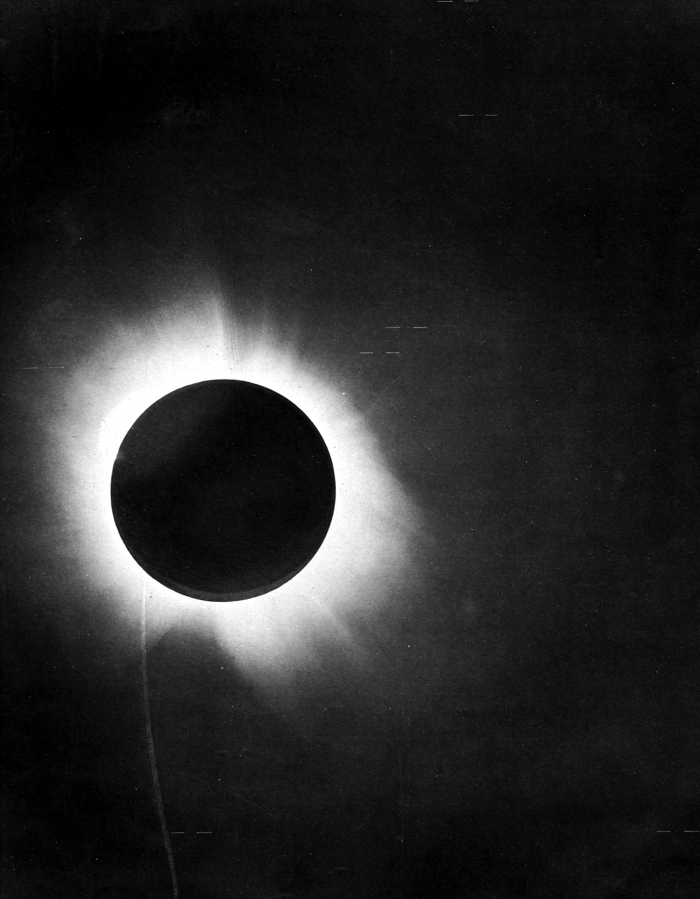Original caption of that image:
From the report of Sir Arthur Eddington on the expedition to verify Albert Einstein's prediction of the bending of light around the sun.
In Plate 1 is given a half-tone reproduction of one of the negatives taken with the 4-inch lens at Sobral. This shows the position of the stars, and, as far as possible in a reproduction of this kind, the character of the images, as there has been no retouching. A number of photographic prints have been made and applications for these from astronomers, who wish to assure themselves of the quality of the photographs, will be considered as as far as possible acceded to.
Source:
F. W. Dyson, A. S. Eddington, and C. Davidson, "A Determination of the Deflection of Light by the Sun's Gravitational Field, from Observations Made at the Total Eclipse of May 29, 1919" Philosophical Transactions of the Royal Society of London. Series A, Containing Papers of a Mathematical or Physical Character (1920): 291-333, on 332.
Public domain in the United States because of age.
(published before 1923).
From Wikipedia, the free encyclopedia;
In physics, mass – energy equivalence is the concept that the mass of a body is a measure of its energy content. In this concept the total internal energy E of a body at rest is equal to the product of its rest mass m and a suitable conversion factor to transform from units of mass to units of energy. If the body is not stationary relative to the observer then account must be made for relativistic effects where m is given by the relativistic mass and E the relativistic energy of the body. Albert Einstein proposed mass – energy equivalence in 1905 in one of his Annus Mirabilis papers entitled "Does the inertia of a body depend upon its energy-content?" The equivalence is described by the famous equation - E = mc2 where E is energy, M is mass, and C is the speed of light in a vacuum. The formula is dimensionally consistent and does not depend on any specific system of measurement units. For example, in many systems of natural units, the speed (scalar) of light is set equal to 1 ('distance'/'time'), and the formula becomes the identity E = M'('distance'2/'time'2)'; hence the term "mass – energy equivalence".
The equation E = mc2 indicates that energy always exhibits mass in whatever form the energy takes. Mass – energy equivalence also means that mass conservation becomes a restatement, or requirement, of the law of energy conservation, which is the first law of thermodynamics. Mass – energy equivalence does not imply that mass may be ″converted″ to energy, and indeed implies the opposite. Modern theory holds that neither mass nor energy may be destroyed, but only moved from one location to another.
In physics, mass must be differentiated from matter, a more poorly defined idea in the physical sciences. Matter, when seen as certain types of particles, can be created and destroyed, but the precursors and products of such reactions retain both the original mass and energy, both of which remain unchanged (conserved) throughout the process. Letting the m in E = mc2 stand for a quantity of "matter" may lead to incorrect results, depending on which of several varying definitions of "matter" are chosen.
E = mc2 has sometimes been used as an explanation for the origin of energy in nuclear processes, but mass – energy equivalence does not explain the origin of such energies. Instead, this relationship merely indicates that the large amounts of energy released in such reactions may exhibit enough mass that the mass - loss may be measured, when the released energy (and its mass) have been removed from the system.
Einstein was not the first to propose a mass – energy relationship.
However, Einstein was the first scientist to propose the E = mc2 formula and the first to interpret mass – energy equivalence as a fundamental principle that follows from the relativistic symmetries of space and time.
"There are something like ten million million million million million million million million million million million million million million (1 with eighty zeroes after it) particles in the region of the universe that we can observe. Where did they all come from? The answer is that, in quantum theory, particles can be created out of energy in the form of particle/antiparticle pairs. But that just raises the question of where the energy came from. The answer is that the total energy of the universe is exactly zero. The matter in the universe is made out of positive energy. However, the matter is all attracting itself by gravity. Two pieces of matter that are close to each other have less energy than the same two pieces a long way apart, because you have to expend energy to separate them against the gravitational force that is pulling them together. Thus, in a sense, the gravitational field has negative energy. In the case of a universe that is approximately uniform in space, one can show that this negative gravitational energy exactly cancels the positive energy represented by the matter. So the total energy of the universe is zero".
Stephen W. Hawking
"There is nothing in the world except empty curved space. Matter, charge, electromagnetism, and other fields are only manifestations of the curvature of space".
John Wheeler
"Energy is the inherent capacity of the universe to make matter exist". Quotations: Superultramodern Science and Philosophy (2005).
Collected Quotes from Albert Einstein
"Reality is merely an illusion, albeit a very persistent one."
"I want to know God's thoughts; the rest are details."
"The only reason for time is so that everything doesn't happen at once."
That which we perceive to be matter is not matter at all, rather light energy producing that which we perceive to be matter.
GEO.

